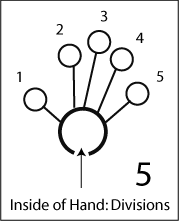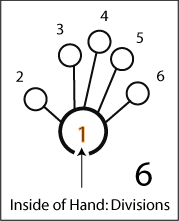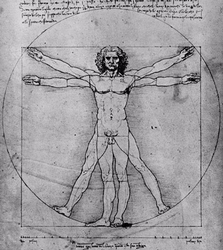
[this
text is in process]
07.28.10
o:O:o
under-st(ar)-(h)anding...
Consider the human hand. A starFish-shaped
appendage assembled by an infinite flow of ever-more diverse
interactivity over thousands of millions of years. If the
truth is written anywhere, it must also be written here.
Arbiter
of our every hope and activity — the hand is a highly
specialized extension of biocognition itself. For at least thousands
of years, we’ve been counting our hands, and for most
if not all of that time, we’ve been counting ‘5’
every time we count a hand. But think more carefully about this matter, for your hand is the primary agent that executes your will. Without it, you would be hard pressed indeed to manipulate anything. Of course, you might use your secondhands — feet. But both hands and feet are required, and both are intimately involved in nearly every possible act that requires any physical component whatsoever.
In short, your hand is the agent of your will.
At first glance, it might seem irrational that there
could be a better or more important way of counting
our own hands — or that the way we count our hands could
be improved such that the result altered our relationship
with intelligence in our favor.
Our species has been counting
our hands since we’ve been counting, and though a surgeon
and layperson might count differently, we all generally agree
that we count ‘10’ when we count our hands —
5 for each hand. I grew up counting this way, the same as
everyone else I know. No one ever showed me any ‘other
way’, nor did I expect such an unlikely thing might
ever happen. This count ‘makes rational sense’,
in a general way, yet there is at least one other way of counting
the hand that makes far more sense — it remembers
unities and links to other scales of form and manifestation.
This makes it ‘more like us’, without defining
‘what that is’.
Many of us learn to count ‘on
our hands’. Our first exposure to counting in general
is often with ‘fingers’, and if our first exposure
is skewed in a way that is commonly invisible, it could
radically cripple our relationship with unity and separation
— in general. This, in turn, would cripple our relationship with our own intelligence.
The meanings about separation and unity
implicit in our counting-games will tend to become the bases of meaning
and relation themselves. Because the numerism we favor grants
value and meaning-precedence to separation, all of our metaphoric
constructs do the same thing.
Anything omitted or mistranslated
in the basis of our counting-games has been similarly omitted
or mistranslated in our congress with metaphoric relations, particularly in how we assemble and evaluate identity.
This means our bases of comparison are completely misfounded, and lead to openly irrational positions which defend themselves (in our persons and cultures) as ‘the only rational position possible’.
From this perspective, we may observe
that it is possible to completely re-author the principles
and potentials of our own intelligence, by gently adjusting
certain root-features of the gardens from which our form of
intelligence takes its inspiration, and ‘how we count’
is a crucial precursor to nearly everything else we do with
intelligence. To reverse the currently catastrophic situation we find ourselves in as regards unity and separation, we can play a new
counting-game, one with the following characteristics:
1: A way which values ‘the
unifying body’ — centers at scales from
which elements emanate.
2: A way of counting which perceives
and sustains multiple simultaneous ‘counts’ of
an entity, at least one of which is known to lead to infinite progressions
of new scales and dimensions of itself.
o:O:o
In order to establish how and why these
matters are of import, we’ll pursue a hand-counting game
that leads to ‘other scales of itself’. To begin,
we will suppose the following:
A: How we count our hands matters because
a subtle shift toward greater general accuracy alters how
we perceive and relate — in general — by establishing
the meanings and linkages of the concepts of unity and separation.
B: That a hand has ‘two sides’,
each with unique counting-features worthy of distinct attention.
The inside has (obvious) lines of division, while the outside is (more
generally) unified.
C: That we shall labor to conserve
multiple models and sums when counting an object — particularly
any organismal symmetry.
o:O:o

The Human Count
Most humans are taught and required
to count their hand as ‘5‘ — for ‘5
members’. The body which unifies the members has a name
— the palm — but it is not counted. In short, ‘the part of the hand that unifies the members doesn’t count’. This seemingly innocuous oversight turns out to have catastrophic ramifications for human intelligence.
Effectively, this means that the metaphor of the unityBody
does not exist in its common form on our planet. This is, in part, because how we count our hands
prescribes certain features of how we form metaphors about unity and separation in
general, and what is included or excluded from those metaphors. Since this element (the palm or unifying body) has neither count nor precedence-value,
it is functionally de-valued. Although it is ‘clear’
that the hand itself is a unity, this too, is discarded as
‘a given’ — and not counted. This mode favors
and enforces a fallacious precedent: that separate members
are the whole and focus of counting in general.
No real attention is paid to which
side of the hand is counted, since in this model there’s
no place-position for sides, whole, scales of assembly, or
unifiers. Our count is flat, linear, and values only the ‘most
divided’ dimension of those available.
We simply count our hands as five. End of story, end of our interest in the topic.
o:O:o

The Beast Count
‘A beast knows what the humans have forgotten: That you must count what has precedence first, both in order to remember its precedence, and to insure that your children do not discard it accidentally...’
For the ‘beast’s count’
, begin by noticing that the inner surface of the hand is
‘the divided side’ — where divisions are
written in more-or-less obvious lines. Turn your left palm
toward your eyes and spread the members of your hand gently.
If you allow your fingers and thumb to curl naturally, you will see very obvious lines or ‘divisions’ in the members attached to the palm (and the palm itself, but this is a matter for another place). On the other side, what you have is many very vague lines, and few, if any, distinct, clear divisions. We will call the inside the side of distinction and the outside the side of unity. Not only are they not at war, or even in confict: both sides are necessary to have a hand in anything at all…
In this way we can establish a model where distinction has more general precedence on what
we’ll call the inside (palm-side) of the hand, whereas
on the outside, the unity of the hand (as a nameworthy assembly)
has precedence over the divisions.
For the ‘beast count’, we grant precedence
to the unityBody — the palm — by counting
it first, as 1. We simply undo the major mistake of modern homo-sapiens in this regard. This establishes that the hand is
founded in unity, first. We then proceed to the thumb
— the ‘thinking member’, and on to the fingers,
(or working members) in order.
Even a ‘beast’ sees the
unifying body first.
The Beast’s Count
preserves and grants ordinal precedence to the counting-and-meaning
value of the unifying body, without which the members are
rendered into isolates. Granting precedence to the unityBody
does not threaten the individuality of the members, [i.e: fingers
co-operating do not comprise a communist nation] but instead
enhances this resource dramatically — each ‘discrete
member’s diversity, uniqueness and prowess is exponentially
magnified in harmonious linkage with the others —
via the palm.
For this and related reasons, the Beast Count is vastly superior
to the Human count, by virtue of its organizing principle and
extensibility to other metaphoric relations involving groups
of any kind.
o:O:o

The Angel Count
‘An angel knows that the most important thing is to count is the unity itself, only then does any ‘portion’ gain meaning…
This count looks on the
outside from above, so turn your left hand palm-away to proceed.
From here we aware of the
Human and Beast Counts, but we see, count and value unities
first. Since the Human Count is included in the Beast Count,
it is preserved, but not ‘re-added’ to produce the
sum.
See the whole, then see
through the whole to the unityBody and members.
1 — for the whole
hand, the unity of it — whereby it is a singular Entity.
1 — for the palm, the unityBody of the hand.
1 — for the unique or ‘thinking’ member
4 — for the ‘working members’, or fingers.
+ — for link to
the next scale of the star.
7+

Now things start to get interesting.
The Angel’s Count sees the unities
and distinctions of the hand, but it values the connectivity-member
highly, and preserves a special place for this understanding
as a part of its count. This is the place where the unityBody
of the hand connects to a similar manifestation of ‘starhand’
at another scale — via the wrist.
The body begins with a unity —
by which the members are connected, and this unity has 5 members,
including a thinking member.
Each of the ‘working members’
linked to the body has 3 major parts, like each of
the ‘working members’ of the hand — fingers.
Each of the body’s working members ends
in a star, except the Head.
The thinking member has 2 basic
sections like its handworthy instance, the thumb.
Yet the ‘thinking member’ of the body has an inverted
starHand — 7 ‘entrances’ — or members
which lead ‘inward’ — only one of them is
physically expressive — the mouth.
Thus the startling symmetries we discovered
in the hand are clearly and uniquely re-expressed at the next
scale — the body.
o:O:o
As a whole, the general counts are
the same:
Hand:
Human: 5
Beast: 6
Angel 7+
Body:
Human: 5
Beast: 6
Angel 7+(!)
The Angel Count conserves
all counts distinctly, then renders them into scale-sets,
which link via a transport that morphs as it crosses the (asymptotic)
scale-boundaries.
o:O:o
The Angel might say: “The Invisible
Hand in the Head hath a second kind of wrist(!).
And the ‘palm of the body’, has the ‘second
scale’ of the Hand’s wrist. Both of these
are invisible...to the eyes that see light. They are visible
to the eyes that see connectivity, however — and those
are — as you say — ‘inside you’.”
|